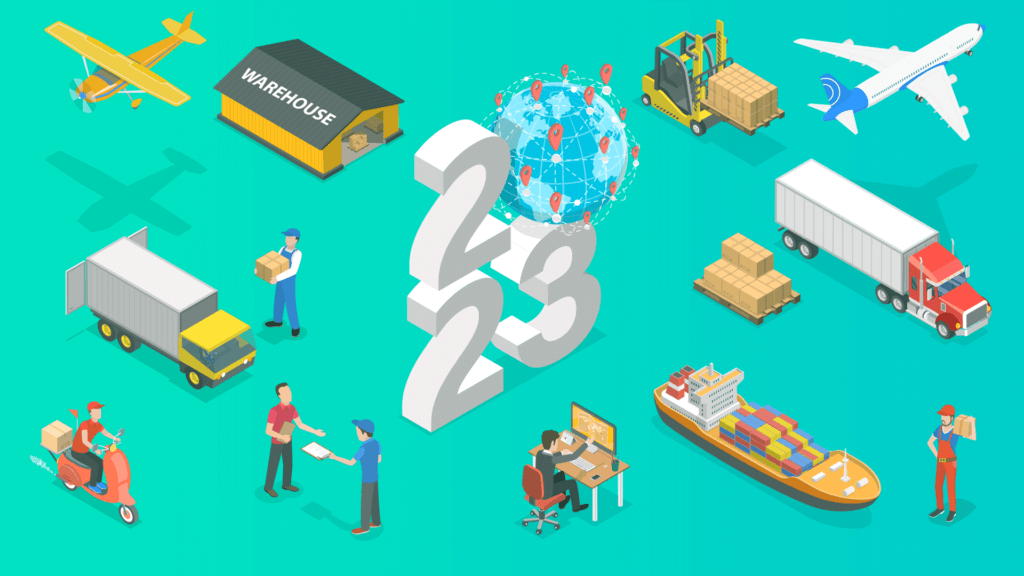
How might supply chains change in 2023? As we move into the new year, we’re exploring some of the supply chain trends and predictions for the next 12 months.
The last few years have been incredibly challenging for all industries – and this was especially true in 2022.
The lingering consequences of the coronavirus pandemic combined with supply chain issues, the geopolitical conflict in Ukraine and global inflation had a huge impact on businesses of all shapes and sizes. From rising energy bills and unexpected costs to reduced stock or staff – organisations were forced to address a myriad of financial and operational problems that made running a business very difficult.
The pandemic in particular revealed the supply chain risks that come with complex and global supply networks – showing just how quickly things can change. Events such as these highlighted the desperate need for a risk-resilient supply chain and the ability to pivot and adapt to mitigating circumstances.
As we continue to navigate a precarious and uncertain economy, it’s never been more important to create more resilient supply chains. This means examining your supply chain to identify vulnerable areas and thinking strategically about how you can invest in making your supply chain more robust.
The value of implementing durability across the supply chain to protect businesses has already been recognised and is predicted as being one of the key, ongoing issues of 2023.
Agility and resiliency, for example, have been highlighted as major topics of the next few months, with some experts arguing that a “diversified enterprise across channels, products, geographies and solutions has a greater likelihood of mitigating risk during the 2023 economic transition”.
Read more here.
Technology is constantly improving – but we’ve really noticed rapid advancement with regard to AI and automation in the past year.
The adoption of AI has more than doubled since 2017, with an increasing number of AI capabilities embedded in organisations over the last five years.[1] This demonstrates its growing prevalence and perceived value within the business world, where it is being used to reduce labour and improve consistency over a wide range of operations.
AI has huge potential in supply chain management as it can perform problem – solving tasks and driving many aspects of the value chain without any manual participation. Although many organisations aren’t engaging with this type of technology, or are hesitant to fully rely on it – these developments underline just how useful embracing the latest technologies can be.
Doing tasks manually can be time-consuming and complicated and increase the margin for inconsistencies and errors. Implementing trusted and efficient technology, however, removes these threats and can help ensure that operations run much more smoothly.
We’ve seen this first-hand as an organisation that helps businesses improve their supply chain sustainability, and know all too well how technology can help overcome the challenges associated with measuring and reporting on key emissions data.
Scope 3 emissions, for example, can be notoriously tricky to report on manually – but using specialist technology designed to automatically collect and collate this data can be a much more efficient and easy method.
With this in mind, we expect to see technology continue to change how supply chains are created, developed – and optimised throughout 2023. When it comes to supply chain predictions – we believe that increasing numbers of businesses from all industries will implement it, or make it a more central part of their operations.
Sustainability is a hot topic – and one which will only increase in importance over the coming year.
The environmental, social and financial impacts of climate change have been recognised globally – reflected in the creation of initiatives like the United Nation’s Sustainable Development Goals (SDGs), as well as governments across the world adopting ambitious carbon cutting and net zero programmes. This has led to increased pressure on businesses to reduce their carbon footprint and demonstrate how they are striving to be a more ethical and sustainable organisation.
This is evident within many company goals and mission statements which are centred around sustainability and social responsibility. They often have specific aims or milestones in place as part of a broader sustainability strategy, with commitments to transparency and accountability.
Creating sustainable supply chains is integral to being a sustainable business, as it ensures that your organisation is environmentally responsible beyond the boundaries of your immediate operations.
Taking action to improve the green credentials of your supply chain is therefore essential for any business looking to improve its carbon footprint, as it enables you to see which areas (or suppliers!) are adversely affecting your sustainability ratings. It’s also a good opportunity to engage with useful initiatives such as ESG and other regulatory reporting.
Considering the leading role that sustainability has played thus far in business, it would be reasonable to assume that sustainability in supply chain management is set to increase in significance in 2023.
As organisations look to adopt and implement sustainability initiatives, the supply chain becomes more important as it is responsible for the organisation’s overall environmental impact – making it the obvious area to address when seeking to reduce that impact.
We have years of experience helping businesses advance their green credentials by providing specialist solutions that simplify and demystify the sustainability journey.
Whether you’re looking to achieve specific goals such as net zero, or simply want to increase your business’s sustainability – we can help. We give your business complete visibility, access and control over the data you require for quick and easy reporting using our carbon reporting software which seamlessly collates emissions data across the year, automatically calculates GHG emissions and accurately reports on Scope 1, 2 and 3 emissions.
Want to know more? Get in touch with our team here.
[1]https://www.mckinsey.com/capabilities/quantumblack/our-insights/the-state-of-ai-in-2022-and-a-half-decade-in-review


Want to know more? Please get in contact with our team here.
Contact Us